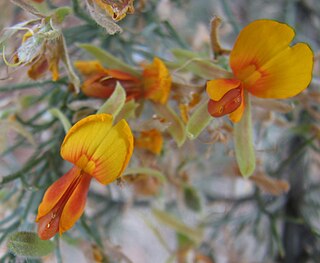
Jacksonia furcellata, commonly known as grey stinkwood, is a species of flowering plant in the family Fabaceae and is endemic to the south-west of Western Australia. It is a prostrate to low-lying, or weeping erect shrub with greyish-green branches, sharply-pointed side branches, its leaves reduced to scales leaves, yellowish-orange flowers, and woody, hairy pods.

Jacksonia sericea, commonly known as waldjumi, is a species of flowering plant in the family Fabaceae and is endemic to the south-west of Western Australia. It is a spreading to prostrate shrub with greyish-green branches, straight, sharply-pointed side branches, leaves reduced to scales, orange flowers with red markings, and woody, densely hairy pods.

Conospermum polycephalum is a species of flowering plant in the family Proteaceae and is endemic to the south-west of Western Australia. It is a spindly or semi-prostrate shrub with dense, thread-like leaves at the base of the plant, and panicles of white, pink or blue, tube-shaped flowers, the fruit a hairy, cream-coloured nut.

Daviesia hakeoides is a species of flowering plant in the family Fabaceae and is endemic to the south-west of Western Australia. It is a shrub with many tangled stems, scattered sharply-pointed phyllodes and yellow or orange and dark red flowers.
Dillwynia dillwynioides is a species of flowering plant in the family Fabaceae and is endemic to the south-west of Western Australia. It is a low-lying or erect, spindly shrub with cylindrical, grooved leaves and yellow, red or orange flowers with yellow, red or orange markings.

Pultenaea empetrifolia is a species of flowering plant in the family Fabaceae and is endemic to the south-west of Western Australia. It is a spindly, prostrate or spreading shrub with down-curved, cylindrical, grooved leaves and yellow to orange and red flowers.
Pultenaea pinifolia is a species of flowering plant in the family Fabaceae and is endemic to the south-west of Western Australia. It is an erect, slender shrub with pine-like leaves and yellow-orange flowers with orange marks.

Gompholobium ovatum is a species of flowering plant in the family Fabaceae and is endemic to the south-west of Western Australia. It is an erect or prostrate shrub with egg-shaped leaves and yellow and red to purple, pea-like flowers.
Bossiaea preissii is a species of flowering plant in the family Fabaceae and is endemic to the south of Western Australia. It is a compact, glabrous shrub with egg-shaped leaves with the narrower end towards the base, and yellow, red, orange or apricot-coloured flowers.
Bossiaea spinescens is a species of flowering plant in the family Fabaceae and is endemic to the south-west of Western Australia. It is a slender, spreading or compact, spiny shrub with oblong to oval leaves and yellow and reddish-brown, pea-like flowers.

Kennedia microphylla is a species of flowering plant in the family Fabaceae and is endemic to the south-west of Western Australia. It is a prostrate, mat-forming creeper with relatively small, trifoliate leaves and red flowers.
Daviesia benthamii is a species of flowering plant in the family Fabaceae and is endemic to the west of Western Australia. It is an erect, bushy shrub with scattered, cylindrical, sharply pointed phyllodes, and yellow-orange and reddish-brown flowers.

Pimelea tinctoria is a species of flowering plant in the family Thymelaeaceae and is endemic to the south-west of Western Australia. It is an erect, spindly shrub with elliptic leaves arranged in opposite pairs, and compact heads of many yellow or yellowish-green flowers usually surrounded by 4 to 7 pairs of egg-shaped to narrowly elliptic yellow and green involucral bracts.
Pimelea villifera is a species of flowering plant in the family Thymelaeaceae and is endemic to the south-west of Western Australia. It is an erect, dense shrub usually with linear to narrowly elliptic leaves arranged in opposite pairs, and compact heads of many white flowers usually surrounded by 6 to 10 pairs of green and yellowish, narrowly egg-shaped involucral bracts.
Chorizema racemosum is a species of flowering plant in the family Fabaceae and is endemic to the southwest of Western Australia. It is a spreading or erect shrub with leathery, linear leaves, and yellowish-orange and red pea flowers.

Chorizema reticulatum is a species of flowering plant in the family Fabaceae and is endemic to the southwest of Western Australia. It is a shrub with erect or ascending stems, crowded lance-shaped leaves, and pink and orange pea flowers.
Chorizema rhynchotropis is a species of flowering plant in the family Fabaceae and is endemic to the southwest of Western Australia. It is a straggling, sprawling or erect shrub with linear, sharply-pointed leaves, and orange or red and pink and yellow pea flowers.
Jacksonia arida is a species of flowering plant in the family Fabaceae and is endemic to Western Australia. It is an erect or prostrate shrub with tangled branches, sharply-pointed branchlets, yellow-orange to orange flowers, and woody pods.

Jacksonia fasciculata is a species of flowering plant in the family Fabaceae and is endemic to the south-west of Western Australia. It is an erect, spiny shrub with sharply-pointed end-branches, leaves reduced to scales and orange flowers with red markings in the axils of branches.

Jacksonia hakeoides is a species of flowering plant in the family Fabaceae and is endemic to the south west of Western Australia. It is a low, densely-branched shrub with sharply-pointed end branches, the leaves reduced to scales, yellow-orange to orange flowers with red markings, and woody, densely hairy pods.












